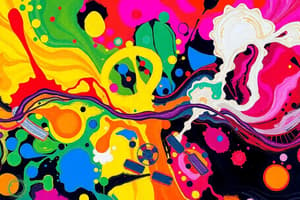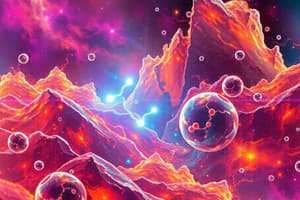Podcast
Questions and Answers
Which of the following best describes the relationship between temperature and reaction rate?
Which of the following best describes the relationship between temperature and reaction rate?
- Lower temperature increases the reaction rate.
- Temperature has no effect on reaction rate.
- Higher temperature decreases the reaction rate.
- Higher temperature increases the reaction rate. (correct)
In a chemical reaction, if substance A is broken down into substance B and substance C, which type of reaction has occurred?
In a chemical reaction, if substance A is broken down into substance B and substance C, which type of reaction has occurred?
- Double Replacement
- Single Replacement
- Synthesis
- Decomposition (correct)
Which of the following is an example of a chemical change?
Which of the following is an example of a chemical change?
- Melting of ice
- Rusting of iron (correct)
- Dissolving sugar in water
- Boiling of water
If two gases are at the same temperature and pressure, what does Avogadro's Law state about their volumes?
If two gases are at the same temperature and pressure, what does Avogadro's Law state about their volumes?
Which of the following describes the composition of an element?
Which of the following describes the composition of an element?
What distinguishes isotopes of the same element?
What distinguishes isotopes of the same element?
In the context of solutions, what is the role of the solute?
In the context of solutions, what is the role of the solute?
Which subatomic particle has a positive charge and is located in the nucleus of an atom?
Which subatomic particle has a positive charge and is located in the nucleus of an atom?
Which branch of chemistry focuses on the qualitative and quantitative analysis of elements and compounds?
Which branch of chemistry focuses on the qualitative and quantitative analysis of elements and compounds?
Which type of chemical bond involves the sharing of electrons between atoms?
Which type of chemical bond involves the sharing of electrons between atoms?
Flashcards
Chemistry
Chemistry
The study of the composition, structure, and properties of substances and their transformations.
Organic Chemistry
Organic Chemistry
Study of compounds containing carbon.
Matter
Matter
Anything that occupies space and has mass.
Physical Change
Physical Change
Signup and view all the flashcards
Element
Element
Signup and view all the flashcards
Atom
Atom
Signup and view all the flashcards
Ionic Bond
Ionic Bond
Signup and view all the flashcards
Reactants
Reactants
Signup and view all the flashcards
Boyle's Law
Boyle's Law
Signup and view all the flashcards
Solute
Solute
Signup and view all the flashcards
Study Notes
Basic Concepts
- Chemistry studies the composition, structure, and properties of substances and their transformations.
- Organic chemistry focuses on carbon-containing compounds.
- Inorganic chemistry studies compounds lacking carbon.
- Analytical chemistry deals with qualitative and quantitative analysis of elements/compounds.
- Physical chemistry examines reaction rates, mechanisms, bonding, and structure.
Matter and States of Matter
- Matter occupies space and has mass.
- Solids have a fixed shape and volume.
- Liquids have a fixed volume but no fixed shape.
- Gases lack a fixed shape or volume.
- Plasma is a collection of charged gaseous particles.
Changes in Matter
- Physical change alters the state/phase without changing chemical composition, such as melting.
- Chemical change alters chemical composition, forming new substances, such as rusting.
Elements and Compounds
- An element is a pure substance that cannot be broken down further.
- A compound consists of two or more elements chemically bonded.
Atoms and Subatomic Particles
- An atom is the smallest unit of an element.
- A proton has a positive charge found in the nucleus.
- A neutron has no charge and is found in the nucleus.
- An electron has a negative charge and orbits the nucleus.
- Isotopes are atoms of the same element with different numbers of neutrons.
- Atomic number refers to the number of protons.
- Mass number refers to the total number of protons and neutrons.
Chemical Bonds
- An ionic bond involves the transfer of electrons, creating charged ions.
- A covalent bond involves the sharing of electrons.
- A metallic bond is an attraction between free electrons and metal ions.
Chemical Reactions
- Reactants are substances that undergo a reaction.
- Products are substances produced by a reaction.
- Synthesis reactions involve combining substances.
- Decomposition reactions involve breaking down substances.
- Single replacement reactions involve one element replacing another.
- Double replacement reactions involve the exchange of ions between two compounds.
Factors Affecting Reaction Rate
- Reaction rate increases with more reactive substances.
- Higher temperature increases reaction rate.
- Higher concentration increases reaction rate.
- More surface area increases reaction rate.
- A catalyst speeds up a reaction without being consumed.
Laws of Chemical Combination
- The Law of Definite Proportions states elements combine in fixed ratios.
- The Law of Multiple Proportions states elements combine in simple whole-number ratios.
- The Law of Combining Weights states elements combine according to their atomic weights.
Stoichiometry
- This is the quantitative relationships in chemical reactions.
Gas Laws
- Boyle's Law: Volume is inversely proportional to pressure at constant temperature.
- Charles' Law: Volume is directly proportional to temperature at constant pressure.
- Combined Gas Law combines Boyle's and Charles' laws.
- Avogadro's Law: Equal volumes of gases contain equal numbers of molecules at the same temperature/pressure.
- Ideal Gas Law: PV = nRT (Pressure × Volume = Moles × Gas Constant × Temperature).
- Graham's Law: Effusion rate is inversely proportional to the square root of molar mass.
- Dalton's Law of Partial Pressure: Total pressure of a gas mixture is the sum of individual gas pressures.
Solutions
- A solute is the substance being dissolved.
- A solvent is the substance doing the dissolving.
- Concentration is the amount of solute in a solution.
- Percent by Mass: (Mass of solute ÷ Total mass) × 100%.
- Percent by Volume: (Volume of solute ÷ Total volume) × 100%.
- Molarity (M): Moles of solute ÷ Volume of solution (L).
- Molality (m): Moles of solute ÷ Mass of solvent (kg).
- Normality (N): Number of equivalents ÷ Volume of solution (L).
Acids and Bases
- Acids donate H+ ions.
- Bases accept H+ ions.
- pH measures acidity (0–7 acidic, 7 neutral, 7–14 basic).
Organic Chemistry
- Alkanes have single bonds.
- Alkenes have double bonds.
- Alkynes have triple bonds.
- Aromatic compounds are cyclic hydrocarbons.
Biological Chemistry
- Carbohydrates serve as an energy source (sugars, starch).
- Proteins consist of amino acids, crucial for growth and repair.
- Nucleic acids, including DNA and RNA, make up genetic material.
Studying That Suits You
Use AI to generate personalized quizzes and flashcards to suit your learning preferences.




